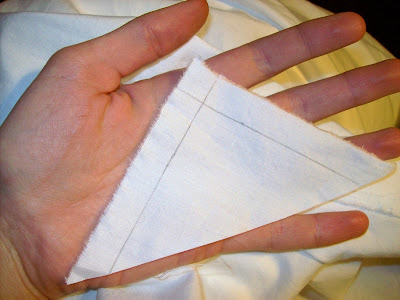1920 Suffragette Costume (Part 1)
My cousin asked me to make a circa 1920 costume for her volunteer work at the Susan B. Anthony house. This is a great learning experience for me as I am new to sewing for other people. Thanks to my wonderful cousin, who is so patient and helpful, I am learning how to do commissions. It's going slowly since we live pretty far away from each other and I have lots of other things going on in my life, but hopefully it won't be too much longer--I started this project in January (yikes!).
So far, I've completed the blouse and am currently working on a suit coat and skirt. We did a lot of research to decide on the look and what patterns to use. My cousin did a fantastic job choosing patterns. For the blouse, she ordered Past Patterns 400 (http://www.pastpatterns.com/400.html) and chose the view without a downturned collar and winged cuffs. I made the blouse in white cotton shirting. Since it is not a closely fitted garment, I did not make a mock-up but rather used my cousin's measurements and checked throughout the cutting and sewing to make sure it would fit.

The blouse has a fly front to hide the buttons. I sewed the buttonholes by hand as I was using my less reliable sewing machine. Plus, they look nicer that way :) I added faux bobbin lace on top of the fly for a decorative element since the blouse is rather plain. I like the "wings" on the front and back of the bodice; they are purely decorative as there is no seam shaping in them.
I didn't get pictures, but the seams are all flat-felled by hand for neatness. I faced the hem with bias tape instead of making a rolled hem because I think it lays flatter this way and looks well-finished. All of the major seams are machine-sewn; I just hand-finished the seams and hem so that they would not be visible from the outside.
The pattern went together really nicely. I had few difficulties, though I was slowed down by several little things like a broken iron and a lack of dressmaker's tracing paper and had to go buy sewing supplies a few times. Yet, I have some minor criticism of the pattern. For one, the cuffs do not open, so there is no way to adjust them and keep them from sliding down over the hand. Hopefully the length is just right so that won't be a problem. Also, the cuff pattern piece isn't drawn evenly, so the side seams don't match up. One is longer. It was easy to fix as I just had to trim the top edge of the cuffs.
Another problem is there is no seam allowance written in the instructions or on the pattern pieces. I used a 5/8" allowance as it's relatively standard. Furthermore, there were no clear instructions for how to sew the center back pleat. I estimated how deep the pleat should be and sewed it, but it seemed pointless, so I removed it and put in a pleat at the neck only, rather than sewn all down the back.
Here's a view of the collar. I used two hooks and sewed thread loops instead of metal eyes for the closure.
Here is a close-up of the lace on the fly front. I hand-tacked it down the middle so the stitching would not be visible. Hopefully the rest of the costume will be complete
I don't have time to cite my research, but I want to make this blouse a Historical Sew Fortnightly entry for #19: HSF Inspiration, due October 15. I was inspired earlier this year by the projects for #11: The Politics of Fashion. 1920 was a benchmark year for women's fashion as clothing became extremely free from the stiff, tailored 1910's fashions and women's clothes evolved into daring, un-corseted styles. The suffragette movement was all about women's rights, yet contradictory to the freedom the suffragettes fought for, they wore very conservative clothing. Perhaps their business-like appearance was intended to give them credibility in the political world and to distinguish themselves as reputable and not radical.
The Challenge: #19 HSF Inspiration
Fabric: 100% cotton shirting (very tightly woven!)
Pattern: Past Patterns 400
Year: 1920
Notions: cotton machine lace, plastic buttons (you can't see them from the outside, so I cheated)
How historically accurate is it? Maybe 90%? Very extensively researched.
Hours to complete: 12 hours (Why did it take so long???!!!! I blame procrastination and perfectionism; it should have taken less than four hours.)
First worn: Not yet!
Total cost: Pattern: $12.00 U.S. (my cousin bought it); fabric from my stash, maybe $5; notions from stash.









Comments
Post a Comment